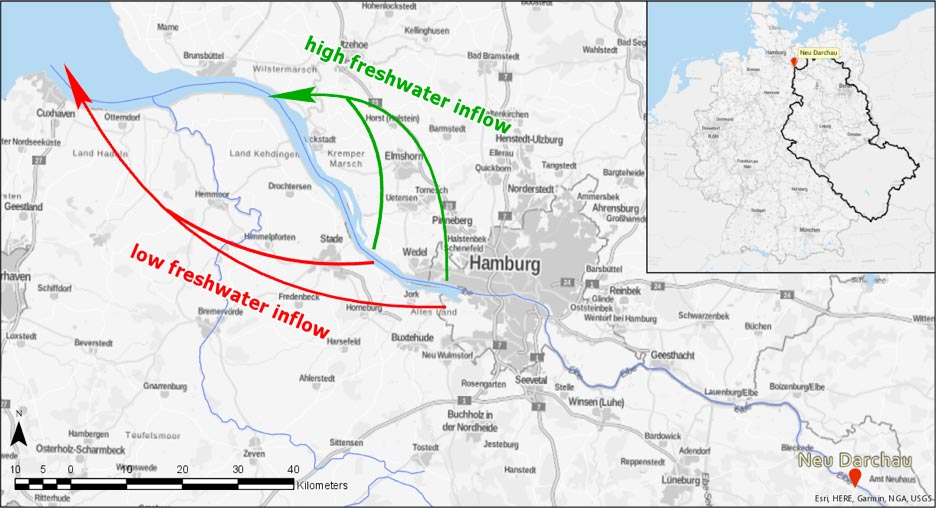
Dumping locations (A and B) with different transport distances and transport costs for dredged sediment at the Tidal Elbe. There are two main areas (C and D), where sediment has to be dredged and transported further down from there.
Waterway/Harbour Manager
Flow forecasts at gauge Neu-Darchau of the next 6 weeks for freshwater inflow
Managing the handling of sediments pushed upstream into the Port of Hamburg by tidal pumping by choosing appropriate sediment management strategies. Water depths of the port and the fairway need to be ensured always for big maritime vessels. Transport distances of dredged material have to be optimized in relation to headwater discharge for cost-benefit and to reduce environmental impact. It also has to be taken into account, that there is a time period in spring when dredging is forbidden due to ecological reasons. For more details: www.stories.imprex.eu
Numerical weather predictions are used as input for a hydrological model to produce probabilistic flow forecasts.
Forecasts are used for planning the dumping location and amount of dredged material

6-week flow forecast initialized at 18th of March 2019 for gauge Neu-Darchau / Elbe. Flow forecasts forced by the weather forecasts of ECMWF in red, forecasts forced by the climatological meteorological forecast (ESP) in blue, observed climatology of the period 1964-2014 in black. Uncertainties of the forecast are displayed as Box-Whisker Plots: the box represents the 25%–75% inter-quantile range, the median is the band inside the box and the whiskers represent the 5% and the 95% quantiles. Blue lines show relevant thresholds for sediment management.
Sediment transport in the tidal Elbe, as in several estuaries, depends significantly on headwater discharge. Therefore relocation sites for dredged materials should be chosen by actual and upcoming river flow rates. Very important time periods are winter and spring. Winter, because relocation near the Port of Hamburg is only allowed from November to April and therefore high amounts of sediment are dredged and relocated during this time period. Spring, because from mid of April until the end of June dredging is forbidden at parts of Tidal Elbe´s fairway in and downstream Hamburg due to ecological reasons. Hence, for spring the amount of sediment to dredge and the dumping locations need to be determined in advance. This amount and the dumping location to select depend among others on the river flow rate at Neu Darchau. By optimizing relocation (sites) and thereby transport distances cost-benefit can be obtained and environmental impact can be reduced.
In the forecast plot two different forecast approaches (Numerical weather prediction in red, climatological meteorological forecast in blue) and the long-term observed flows (black) for the next 6 weeks are presented. A freshwater inflow smaller than 500 m³/s implies too little natural downstream transport of sediments.
In the next six weeks both forecast approaches indicate that predicted streamflow for the next two or three weeks will be sufficient, but after that it shows a tendency to low flow situations. As a consequence of last year’s long and intense low flow season, the natural water storages in the catchment (soil moisture and groundwater storage) are still low and not able to compensate the forecasted lack of rain. Hence, freshwater inflow seems to be lower than usual at this time of the year.
Given the forecast of a high probability of normal freshwater inflow for the near future, the decision-makers increase the amount of dredged material in the next two to three weeks and relocate it further downstream (dumping location B, green arrows) to a stretch of the river where it will be transported naturally to the open sea. Given the forecast of a high probability of low flow afterwards, the natural downstream transport will not be enough and there is a need to schedule longer and more cost intensive transports to the open sea (dumping location A, red arrows) for the beginning of April until the work has to be stopped mid of April.

Four-month hydrological forecasts from EFAS-Seasonal. (a) Ensemble hydrographs for streamflow (light blue) and groundwater levels (dark blue) for the Lower Thames (LT) catchment. Exceedance thresholds (based on records from 1994 to 2014) are shown as Q10 (dashed line) and Q50 (dotted line). (b) Choropleth map shows the maximum probability that the full hydrograph ensemble for a catchment exceeds the Q10 streamflow threshold in a given month.

Same as above, but based on the “improved” EFAS-Seasonal forecast.